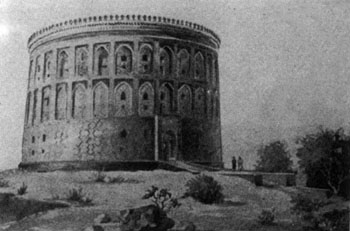Museum open 9 am-6 pm daily.
After so much death and religion it's a relief to get
clear of the city center and inhale some secularity on the hill from which
Ulug Bek studied the heavens. The remains of his observatory are 20 minutes'
walk north of the bazaar up the Tashkent road. Alternatively, take marshrutnoe
taxi 17 from the Hotel Samarkand or the bazaar.
The Conquest of the Stars
The grandson of Tamerlane, Ulug Bek was less interested
in conquering the earth than  the
stars. His was the best-equipped observatory in the medieval world; a magnet
for leading scientists and a center of progressive, often heretical thought.
'Where knowledge starts religion ends/ was the motto of his teacher, Kazi
Zade Rumi, and Ulug Bek's quest for enlightenment led him to sponsor debates
on such topics as the existence of God. This did not go down too well with
Muslim orthodoxy, and among those who found his beliefs hard to stomach
was his own son, who assassinated him on 29 October 1449. Shortly afterwards,
religious fanatics tore down the observatory.
the
stars. His was the best-equipped observatory in the medieval world; a magnet
for leading scientists and a center of progressive, often heretical thought.
'Where knowledge starts religion ends/ was the motto of his teacher, Kazi
Zade Rumi, and Ulug Bek's quest for enlightenment led him to sponsor debates
on such topics as the existence of God. This did not go down too well with
Muslim orthodoxy, and among those who found his beliefs hard to stomach
was his own son, who assassinated him on 29 October 1449. Shortly afterwards,
religious fanatics tore down the observatory.
 Ulug
Bek's astronomical observations, which put him on a par with Copernicus
or Kepler, did not become known in the West until 1648, when a copy of
his Catalogue of Stars was discovered in Oxford's Bodleian Library. He
had plotted the position of the moon, the planets, the sun and 1018 other
stars with amazing precision, and calculated the length of the year to
within 58 seconds (or even less; the earth span slower then than it does
now). These were some of the greatest achievements of the 'non-optical'
(pre-telescope) era of astronomy.
Ulug
Bek's astronomical observations, which put him on a par with Copernicus
or Kepler, did not become known in the West until 1648, when a copy of
his Catalogue of Stars was discovered in Oxford's Bodleian Library. He
had plotted the position of the moon, the planets, the sun and 1018 other
stars with amazing precision, and calculated the length of the year to
within 58 seconds (or even less; the earth span slower then than it does
now). These were some of the greatest achievements of the 'non-optical'
(pre-telescope) era of astronomy.
Having fallen victim to one orthodoxy, Ulug Bek was a
ready-made hero for another. The Soviets made him the object of a minor
cult and officially designated his murder as 'tragic'.
What nobody knew was where, or quite how, Ulug Bek had
worked. Then in 1908, after years spent studying ancient manuscripts, a
Russian primary school teacher, amateur archaeologist and former army officer
called Vladimir Viatkin unearthed the lower portion of a giant sextant
on Kukhak Hill beside the road to Tashkent. It was one of the major finds
of the 20th century.
The original sextant was a perfect arc of marble-clad
brick, 63 metres long with a radius of 40 m, calibrated in degrees and
minutes, decorated with the signs of the zodiac and aligned with one of
the earth's meridians. Observations and measurements were made  with
an astrolabe mounted on metal rails either side of the sextant. What survives,
complete with calibrations and fragments of rail, is the lower section
of the arc, set in a deep rock trench to minimize disturbances from earth
tremors. The arc originally continued upwards above the trench inside a
round, three-storeyed observatory at least 30 m high. Traces of its foundations
are all that remain. The top two floors were arcades used as solar and
lunar calendars. Ulug Bek probably used the ground floor as a summer residence.
There is a small museum on Uzbek astronomy and the opening of Tamerlane's
tomb (see Gur Emir below). The astronomy section includes an old engraving
of great astronomers in which Ulug Bek sits alongside Copernicus and Galileo
dressed as a Cossack, whose garb was the most eastern-looking the engraver
could envisage. The modest grave near the entrance to the sextant is Viatkin's;
he was buried here in
with
an astrolabe mounted on metal rails either side of the sextant. What survives,
complete with calibrations and fragments of rail, is the lower section
of the arc, set in a deep rock trench to minimize disturbances from earth
tremors. The arc originally continued upwards above the trench inside a
round, three-storeyed observatory at least 30 m high. Traces of its foundations
are all that remain. The top two floors were arcades used as solar and
lunar calendars. Ulug Bek probably used the ground floor as a summer residence.
There is a small museum on Uzbek astronomy and the opening of Tamerlane's
tomb (see Gur Emir below). The astronomy section includes an old engraving
of great astronomers in which Ulug Bek sits alongside Copernicus and Galileo
dressed as a Cossack, whose garb was the most eastern-looking the engraver
could envisage. The modest grave near the entrance to the sextant is Viatkin's;
he was buried here in
accordance with his will.
[back]
